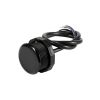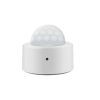Infrared Sensor
Active Non-contact Infrared Sensor, 2cm~150cm
Passive Infrared Sensor for Human Motion, 10m, 120°
Active Infrared Sensor for Indoor/Outdoor
Infrared Photoelectric Sensor, Infrared Spectrum Analysis
Pyroelectric Human Infrared Sensor, DC 5-12V
Non-contact High Temperature Infrared Sensor, PIR, 4-20mA/RS485 Output
Infrared Ranging Sensor Module, I2C Output
Good price infrared sensors for sale online. Infrared sensors are commonly used for object detection and temperature measurement. They have many advantages and are widely used in various lighting control, industrial detection, smart security and other fields. According to their working methods, infrared sensors can be divided into active and passive types. SUCH infrared sensors are affordable, high-quality infrared sensors have simple structures, small sizes, strong and durable, and are sensitive to reactions. You can buy our infrared sensors with confidence.
What is an infrared sensor?
An infrared sensor (IR Sensor) is a sensing device that uses the characteristics of infrared radiation to detect target objects. It can sense the infrared radiation energy emitted by an object, or actively emit infrared light and receive reflected signals to determine whether the target exists, whether its position changes, or whether the temperature fluctuates. Since infrared radiation is an electromagnetic wave emitted by any object with a temperature above absolute zero, infrared sensors can achieve efficient detection in non-contact, quiet, dark and other environments.
How does an infrared sensor work?
 Active infrared sensor:
Active infrared sensor:
An active infrared sensor consists of two parts: an infrared transmitter and an infrared receiver. The transmitter continuously emits infrared light of a certain wavelength. When an object approaches or passes through the infrared light path, reflection or obstruction will occur. The receiver detects the change in the intensity of the reflected infrared light, and then determines whether a target appears or moves.
 Passive infrared sensor:
Passive infrared sensor:
The passive infrared sensor does not actively emit any signal. It only detects changes in infrared radiation in the surrounding environment, especially infrared energy released by heat sources such as the human body. When the thermal infrared radiation in the sensing area changes, the sensor outputs a weak electrical signal and responds with signal amplification and logic processing circuit.
What are the advantages of infrared sensors?
- Non-contact sensing: Suitable for high temperature, dangerous or easily polluted environments.
- Fast response speed: Millisecond triggering can be achieved.
- High sensitivity: Can detect tiny changes in infrared energy.
- Low power consumption: especially passive, long-term operation consumes less power.
- Compact size: Can be embedded in portable devices or smart systems.
- Strong adaptability: Can still work in dark, dusty, and smoky environments.
What are the application scenarios of infrared sensors?
- Smart home: Human body induction lights, automatic corridor lighting, smart air conditioners/TVs that sense human presence for energy-saving control.
- Security systems: Anti-theft alarms (PIR intrusion detection), automatic identification and switching of access control systems.
- Industrial automation: Object counting, positioning conveyor belt materials, equipment high temperature monitoring and non-contact temperature control.
- Medical and health: Non-contact body temperature measurement (ear thermometer/forehead thermometer), infrared thermal imaging assisted diagnosis.
- Automotive electronics: Driver monitoring (fatigue detection), automatic braking system, parking assistance infrared detection.






















